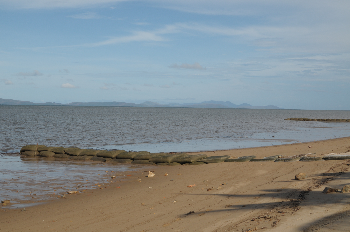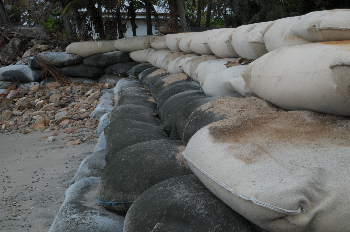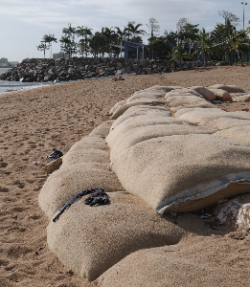 |
When Tropical Cyclone Yasi made landfall on Australia’s Queensland coast in February 2011, it presented a major challange to the coastal infrastructure. This category 5 cyclone–the most-threatening rating–included wind gusts up to 290 km/h (180 mph). Up the Queensland coast it turned from Cardwell to Innisfail, creating a 7m surge that scoured at the shore, destroyed property, and delivered floods that damaged the region’s infrastructure.
Four significant ELCOROCK® structures took the full force of cyclone Yasi and provided the product with a real test of its capabilities.
ELCOROCK® is a beach erosion protection system that utilizes sand-filled geotextile containers for the creation of groynes, shoreline revetments and breakwaters. Developed in Australia, the system is designed for durability against severe storms. And with the ability to use local fill in the structures (e.g., sand, soil, gravel, recycled material, etc.), they keep construction costs down without sacrificing structural integrity. ELCOROCK® structures have even outperformed many traditional hard structures during storms.
Inspection of the ELCOROCK® structures two weeks after Cyclone Yasi showed little or no damage to the actual containers. The integrity of the groynes and walls remained intact while a number of harder retaining walls and sea walls experienced various degrees of failure.
 |
To this day, the structures continue to provide the erosion control they were originally designed for.
A DECADE OF PROOF
In January 2010, the Australia-based Geosynthetic Centre of Excellence conducted research on a 2001-installed ELCOROCK® coastal erosion system at Maroochydore. These groynes were the first structures to use the unique vandal-deterrent geotextile developed for the harsh coastal environment. The results showed a minimal loss of strength despite being exposed to the Queensland sunlight and cyclones through the decade.
This research is important, as it confirms the system’s resistance to UV exposure and abrasion from sand. The in-service exhumation project supported the accelerated UV exposure testing conducted over the past year, where international laboratories tested the ELCOROCK® system for 6,000 hours in high ultra violet radiation, humidity and temperature to accelerate weathering. This is 40 times the international standard for geotextile accelerated UV testing of 150 hours.
The use of the high durability, vandal-deterrent geotextile has been essential to the structures performing so well. The research results have confirmed a 20-year life expectancy for these geotextile container structures.
ELCOROCK® has been supported by extensive R&D over the past 15 years, including extensive stability testing at the Manly Water Research Laboratory in 2009. For more information, visit www.elcorock.com or contact Neil Taylor on n.taylor@geofabrics.com.au.
 |
Neil Taylor is the Business Development Manager for Coastal Systems at Geofabrics Australasia Pty Ltd, www.geofabrics.com.au.











